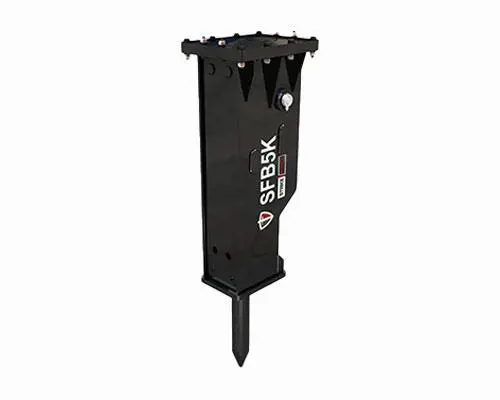This is not the best breaker | Strike Force SFB750
Understanding Hydraulic Breakers: A Look at the Bradco Strike Force
What Does a Breaker Do?
Hydraulic breakers are designed for jobs where brute force is needed—busting through concrete, splitting rock, or even tamping soil and driving posts. They're commonly used on skid steers, compact track loaders, and excavators with the right mounts.
While the primary use is breaking concrete and large rocks, different tool tips can expand functionality. Some come with dished ends for driving fence posts (use caution—they can split the post), or flat plates for compacting soil in trenches.
How Breakers Work
The internal mechanism is fairly straightforward. A hammer point moves back and forth inside a sealed pack, backed by a nitrogen charge that acts like a shock absorber. Over time, this nitrogen can leak, requiring a recharge to maintain performance.
More premium models replace this system with advanced accumulators that require little or no maintenance, along with reinforced casings and longer-lasting internals.
Why the Bradco Strike Force Stands Out
The Bradco Strike Force breaker falls into the "better" category when compared to other options. While it’s not the highest-end model, it offers solid construction, practical features, and strong value for its price point.
Manufactured in South Korea, it stands apart from lower-quality imports flooding the market. You’ll find thicker housings, higher-grade steel, and more robust mounting hardware. It's built to take a beating in trenches or against hard stone without falling apart.
Mounting and Compatibility
This breaker can be mounted to both skid steers and excavators. Mounting hardware is designed to fit standard quick couplers, but swapping between machine types may require a bit of know-how and setup. It’s offered with both skid steer and Kubota-specific mounts, depending on what you're running.
The mounting plate itself is built from heavy steel and includes features like integrated steps for easier machine entry and exit.
Parts and Longevity
Each Bradco breaker ships with key spare parts: a second working point (the $400, 40-pound tip) and an extra seal kit. These help extend the life of the breaker without needing to hunt down replacements later.
While seal maintenance is eventually necessary, the included extras mean you’re better prepared right out of the gate.
Operating Tips for Longevity
Running a breaker correctly makes all the difference. Most machines don’t need high-flow hydraulics—standard flow will do the job just fine. The key is pressure and positioning, not raw speed.
The most common mistake operators make is using the tool for prying. Side-loading the point can ruin internal seals and lead to failure. Always apply force straight down and avoid twisting or leveraging against rocks or concrete.
Keep in mind that these tools can kick up chips, especially in harder materials. A demolition door is a necessary safety addition for protection during operation.
Is It Worth Owning a Breaker?
While breakers have traditionally been rental-only tools due to price, options like the Bradco Strike Force bring ownership within reach. If you have occasional rock-breaking or concrete work, this is a tool worth having around.
It's backed by solid parts support and offers professional-grade construction without the premium price tag. Whether you're on a job site or working your own land, it's a smart, long-term investment.
Need Help Choosing?
If you're exploring attachments or have parts and service needs, Messick's is ready to help. Contact us at 800-222-3373 or visit messicks.com to learn more.












